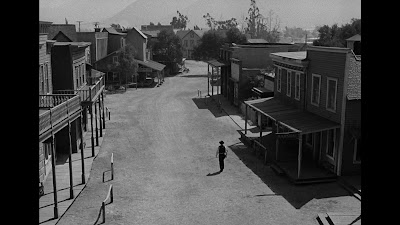 |
| High Noon, Stanley Kramer Productions, 1952 |
The phrase “High Noon” is well known in the US, and in many countries, from a 1952 movie of the same title, starring Gary Cooper, which depicts a Western town Marshall facing the return of the baddie he put in jail years ago, after the corrupt political system has released him.
Quick plot summary: Frank Miller will arrive on the noon train, and his main purpose in returning is to kill Will Kane, the Marshall who sent him to jail. Miller is an ominous character, well known in the town, and Kane, recently married to a handsome Quaker woman (Grace Kelly), has to decide if he will run off with his bride or face Miller.
He decides, despite the protests of his bride, that running off to avoid the confrontation is not the way to solve the problem. So he decides to stay and face Miller. He travels through the town and asks for help to face the criminal and his three cronies, who are already waiting at the railroad station.
Everybody forsakes Kane, through cowardice or perceived self-preservation. So he is left to face Kane and his cronies alone at Noon when the train arrives. His wife declares she will leave him if he follows this course of action, and his former girlfriend, Helen Ramirez, won’t take the risk of standing by him.
The movie, written by Carl Foreman, was an allegory to demonstrate what was going on during the early 1950’s, when the HUAC (House Un-American Activities Committee) of the US Government was intimidating the entire Hollywood community of actors, writers, producers, directors, etc with a “blacklist” of supposed Communist subversives in the film industry. This produced a meltdown of creativity that lasted for many years, and ruined the lives of many gifted people, such as Dalton Trumbo, not to mention the quality of Hollywood films for almost a decade.
Since then, the phrase “High Noon” has entered the vernacular as a seminal confrontation which defines you and your enemies.; a decision that will change your life and the lives of others, probably which will define the rest of your journey.
We can list many historical events that are “high noon.” President Kennedy and the Cuban Missile Crisis; President Reagan with “Tear down this wall;” Winston Churchill with his lone stand against Hitler in WWII; the lone individual facing the tanks at Tiananmen Square. You all know the stories.
The recent elimination of Qaseem Soleimani, was Trump’s High Noon. Given the information that was available to him, he could have taken the PC decision (see: Obama, Clinton) and not take him out, allowing what would happen next to happen (see 9/11). Or, he could take positive and clear action which he knew would be politically divisive, and lend fuel to the fire of his enemies (in the US).
We all have our High Noon. Our life is defined by how we manage it.
So the lesson for us in business and leadership is what? Hold to your principles, do what you know is right and needs to be done; don’t be dissuaded by weakness and fear. If you die (ie.,fired etc.), it is better than living as a roach on the end of someone else’s joint.
It is sometimes very difficult to pursue what you know is right when you feel others don’t support you, doubt you, or just won’t help. A little shyly because of what is next, I remember a line by Tommy Lee Jones in Men In Black 3 which went more or less as: “ The most dangerous force in the universe is regret.”
James Joyce, in “Portrait of the Artist as a Young Man” says,
“I do not fear to be alone or to be spurned for another or to leave whatever I have to leave. And I am not afraid to make a mistake, even a great mistake, a lifelong mistake and perhaps as long as eternity too.”
By contrast, T.S. Eliot, in “The Love Song of J. Alfred Prufrock” says,
“Do I dare
Disturb the universe?
In a minute there is time
For decisions and revisions which a minute will reverse.”
For me, the operative lyric is “The Road Not Taken” by Robert Frost. This poem is worthy of complete quotation here:
Two roads diverged in a yellow wood,
And sorry I could not travel both
And be one traveler, long I stood
And looked down one as far as I could
To where it bent in the undergrowth;
Then took the other, as just as fair,
And having perhaps the better claim,
Because it was grassy and wanted wear;
Though as for that the passing there
Had worn them really about the same,
And both that morning equally lay
In leaves no step had trodden black.
Oh, I kept the first for another day!
Yet knowing how way leads on to way,
I doubted if I should ever come back.
I shall be telling this with a sigh
Somewhere ages and ages hence:
Two roads diverged in a wood, and I—
I took the one less traveled by,
And that has made all the difference.
















